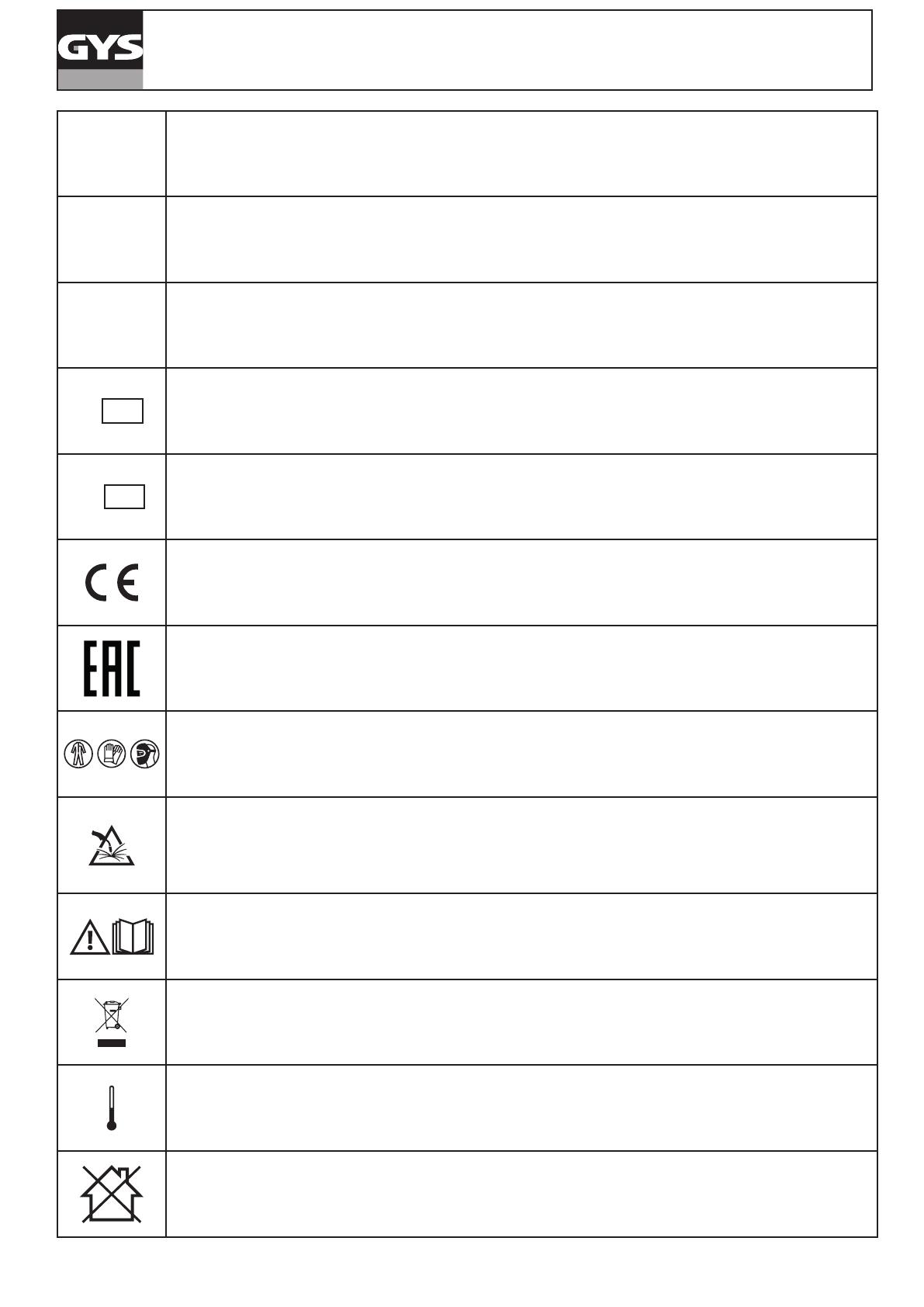
57
TRIMIG 200-4S / 250-4S.DV / 300-4S
I1eff
- Courant d’alimentation effectif maximal.
- Maximum effective supply current.
- Maximaler tatsächlicher Versorgungsstrom.
- Corriente de alimentación efectiva máxima.
- Максимальный эффективный сетевой ток.
- Maximale effectieve voedingstroom.
- Corrente di alimentazione effettivo massimo.
EN60974-1
EN60974-5
EN60974-10
- L’appareil respecte les normes EN60974-1, EN60974-5, EN60974-10.
- The device complies with EN60974-1, EN60974-5, EN60974-10 standard relative to welding units.
- Das Gerät ENtspricht der Norm EN60974-1, EN60974-5, EN60974-10 für Schweißgeräte.
- El aparato está conforme a las normas EN60974-1, EN60974-5, EN60974-10 referENte a los aparatos de soldadura.
- Аппарат соответствует европейской норме EN60974-1, EN60974-5, EN60974-10.
- Dit toestel voldoet aan de EN60974-1, EN60974-5, EN60974-10 norm.
- Il dispositivo rispetta las normas
EN60974-1, EN60974-5, EN60974-10.
X(40°C)
- Facteur de marche selon la norme EN 60974-1 (10 minutes – 40°C).
- Duty cycle according to the standar EN 60974-1 (10 minutes – 40°C).
- Einschaltdauer gemäß EN 60974-1 (10 Minuten – 40°C).
- Factor de marcha según la norma EN 60974-1 (10 minutos – 40°C).
- ПВ% по норме EN 60974-1 (10 минут – 40°С).
- De vermogensfactor volgens de EN60974-1 norm (10 minuten - 40°C).
- Ciclo di lavoro secondo la norma EN 60974-1 (10 minuti – 40°C).
I2
...%
- I2: courant de soudage conventionnnel correspondant.
- I2: corresponding conventional welding current.
- I2: entsprechender Schweißstrom.
- I2: Corrientes correspondientes.
- I2: Токи, соответствующие Х*.
- I2 : overeenkomstige conventionele lasstroom.
- I2: corrente di saldatura convenzionale corrispondente
U2
...%
- U2: Tensions conventionnelles en charges correspondantes.
- U2: conventional voltages in corresponding load.
- U2: entsprechende Arbeitsspannung.
- U2: Tensiones convencionales en carga.
- U2: соответствующие сварочные напряжения*.
- U2: conventionele spanning in corresponderende belasting.
- U2: Tensioni convenzionali in cariche corrispondenti.
- Appareil conforme aux directives européennes. La déclaration de conformité est disponible sur notre site internet.
- The device complies with European Directive. The certicate of compliance is available on our website.
- Gerät entspricht europäischen Richtlinien. Die Konformitätserklärung nden Sie auf unsere Webseite.
- El aparato está conforme a las normas europeas. La declaración de conformidad está disponible en nuestra página Web.
- Устройство соответствует европейским нормам. Декларация соответствия есть на нашем сайте.
- Het toestel is in overeenstemming met de Europese richtlijnen. De conformiteitsverklaring is te vinden op onze internetsite.
- Dispositivo in conformità con le norme europee. La dichiarazione di conformità è disponibile sul nostro sito internet.
- Marque de conformité EAC (Communauté économique Eurasienne).
- Conformity mark EAC (Eurasian Economic Commission).
- EAC-Konformitätszeichen (Eurasische Wirtschaftsgemeinschaft).
- Marca de conformidad EAC (Comunidad económica euroasiática).
- Маркировка соответствия EAC (Евразийское экономическое сообщество).
- EAC (Euraziatische Economische Gemeenschap) merkteken van overeenstemming.
- Marca di conformità EAC (Comunità Economica Eurasiatica)
- L’arc électrique produit des rayons dangereux pour les yeux et la peau (protégez-vous !).
- The electric arc produces dangerous rays for eyes and skin (protect yourself !).
- Der elektrische Lichtbogen verursacht Strahlungen auf Augen und Haut (Schützen Sie sich !).
- El arco produce rayos peligrosos para los ojos y la piel (¡ Protéjase !).
- Электрическая дуга производит опасные лучи для глаз и кожи (защитите себя!). - Внимание! Сварка может вызвать пожар или взрыв.
- De elektrische boog veroorzaakt gevaarlijke stralen voor ogen en huid (bescherm uzelf!)
- L’arco elettrico produce delle radiazioni pericolose per gli occhi e per la pelle (proteggersi!).
- Attention, souder peut déclencher un feu ou une explosion.
- Caution, welding can produce re or explosion.
- Achtung! Schweißen kann Feuer oder Explosion verursachen.
- Cuidado, soldar puede iniciar un fuego o una explosión.
- Внимание! Сварка может вызвать пожар или взрыв.
- Let op, het lassen kan brand of explosie veroorzaken.
- Attenzione, saldare potrebbe far scatenare un incendio o un’esplosione.
- Attenzione! Leggere il manuale d’istruzioni prima dell’uso.
- Attention ! Lire le manuel d’instruction avant utilisation.
- Caution ! Read the user manual.
- Achtung! Lesen Sie die Betriebsanleitung.
- Cuidado, leer las instrucciones de utilización.
- Внимание ! Читайте инструкцию по использованию.
- Let op! Lees voorzichtig de gebruiksaanwijzing.
- Attenzione! Leggere il manuale d’istruzioni prima dell’uso.
- Produit faisant l'objet d'une collecte sélective - Ne pas jeter dans une poubelle domestique.
- Separate collection required, Do not throw in a domestic dustbin.
- Für die Entsorgung Ihres Gerätes gelten besondere Bestimmungen (Sondermüll). Es darf nicht mit dem Hausmüll entsorgt werden.
- Este aparato es objeto de una recolección selectiva. No debe ser tirado en un cubo doméstico.
- Продукт требует специальной утилизации. Не выбрасывать с бытовыми отходами.
- Afzonderlijke inzameling vereist. Gooi niet in het huishoudelijk afval.
- Prodotto soggetto alla raccolta differenziata - Non buttare nei riuti domestici.
- Information sur la température (protection thermique)
- Temperature information (thermal protection)
- Information zur Temperatur (Thermoschutz)
- Información de la temperatura (protección térmica)
- Информация по температуре (термозащита)
- Informatie over de temperatuur (thermische beveiliging)
- Informazione sulla temperatura (protezione termiche)
- Ne pas utiliser en zones résidentielles (CEM)
- Not for use in residential areas (EMC)
- Nicht für die Benutzung in Wohnräumen geeignet. (EMV)
- No usar en areas residenciales (CEM).
- Не использовать в жилый районах (ЭМС)
- Niet gebruiken in woongebieden (EMC)
- Non utilizzare in aree residenziali (EMC)



























































